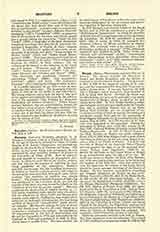

Beccarria, GIOVANNI BATTISTA, physicist, b. at Mondovi, October 3, 1716; d. at Turin, May 27, 1781. At the age of sixteen he entered the Order of Clerks Regular of St. Joseph Calasanctius, and successively taught in the Scuole Pie of Palermo and Rome. His ability as instructor being soon recognized, he was appointed by royal authority professor of physics in the University of Turin (1748). Here he ardently devoted himself to researches on atmospheric electricity, in which he made liberal use of kites, rockets, and iron wire for the purpose of exploring the electrical conditions of the atmosphere. Henley’s pith-ball electroscope was his recording instrument. In broken or stormy weather, positive and negative electrification were detected; whereas in calm, serene weather “the excessive or positive was always found”. The sinuous or forked character of lightning was attributed to the resistance of the air; and the rupture of the shoes of a man struck by a flash, to the “moisture of the feet flying into vapour”. Beccaria confirmed the observation of Andrew Gordon (q.v.) that water evaporates more rapidly when electrified; also the conclusion of Abbe‘s Nollet and Menon that animals (cats, pigeons, chaffinches) lose weight when subjected to prolonged electrification, the loss being ascribed to increased “transpiration” under electrical stimulus. He was also among the first to recognize and clearly state that the electrical charge on a conductor is confined to the surface. An experimental demonstration of this law of electrostatics was devised by Cavendish in 1775 and independently by Coulomb in 1788 and popularized in 1816 by Biot, whose name it usually bears. Beccaria adopted the two-fluid theory of Franklin as well as the views of the American philosopher on the preventive and protective functions of lightning conductors.
In 1755 Beccaria was elected Fellow of the Royal Society, and in 1766 he contributed a paper to the “Philosophical Transactions”, in which he describes (in Latin) five of the more important of his experimental researches. In 1770 he contributed a second paper (also in Latin) in which he expounds five theorems followed by fifteen corollaries in electrostatics. His principal work is his treatise “Dell’ elettricismo artificiale e naturale” (1753), which was translated into English in 1778. Other works are “Lettere sull’ elettricismo” (1758); “Experimenta atque observationes quibus electricitas vindex late constituitur” (1769); and “Dell’ elettricita terrestre atmosferica a cielo sereno” (1775).
BROTHER POTAMIAN

